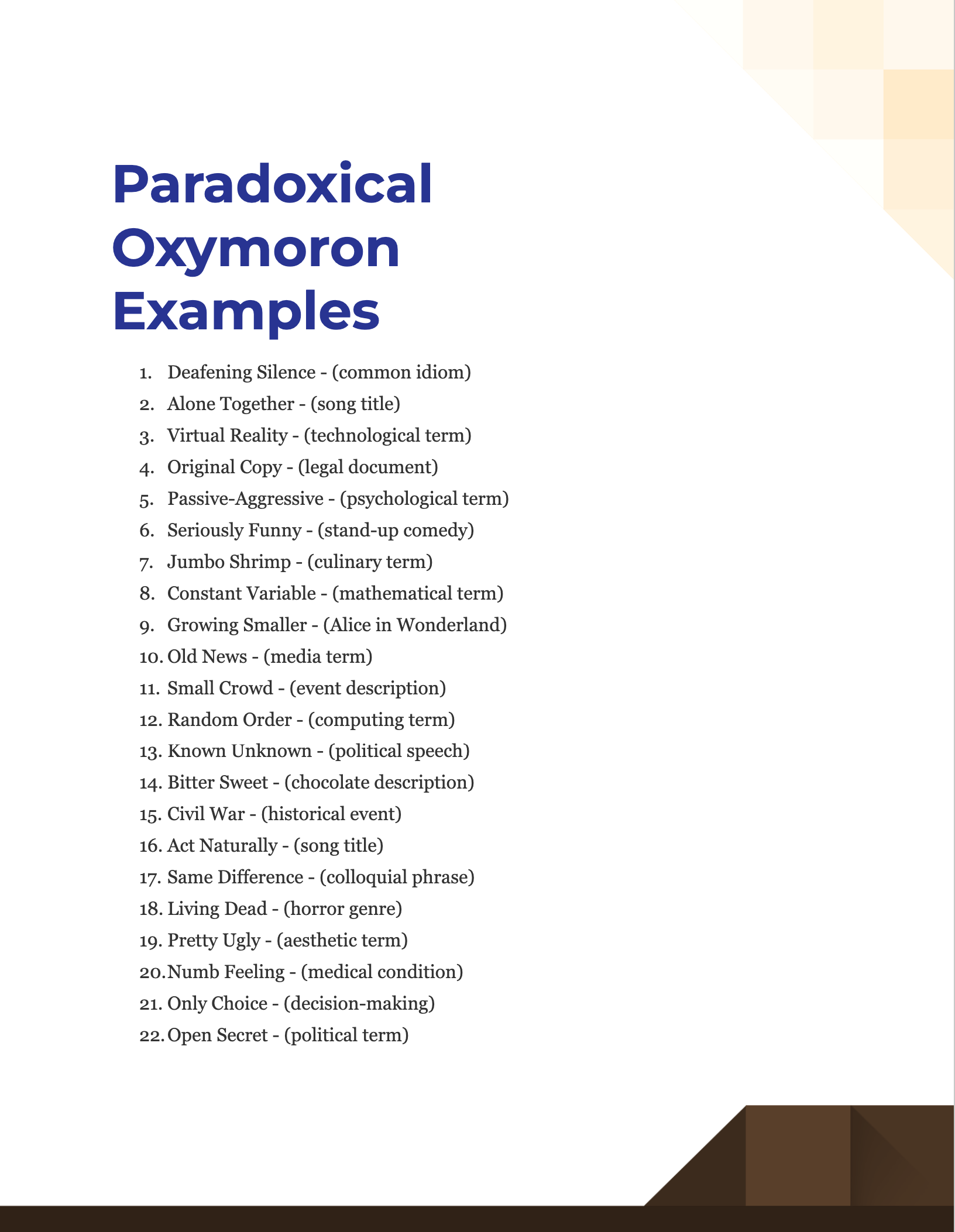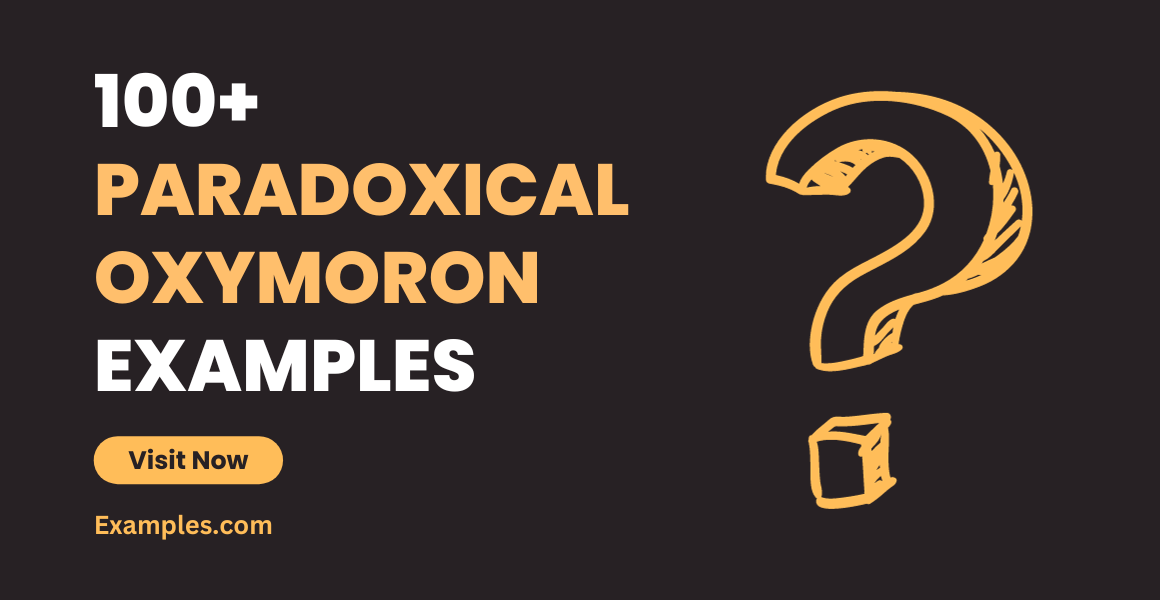99+ Paradoxical Oxymoron Examples
Step into the paradoxical world of oxymorons, where contradictions co-exist in harmony. This guide offers you a treasure trove of paradoxical oxymorons, techniques to write your own, and tips to grasp their captivating essence. If you’re new to the concept of oxymorons, you might want to start with understanding What is Oxymoron?.
What is a Paradoxical Oxymoron? – Definition
A paradoxical oxymoron is a figure of speech that combines contradictory terms to create a phrase with a deeper, often ironic, meaning. While an oxymoron usually contains two opposite words, the “paradoxical” part adds another layer by defying logical expectations, yet somehow making sense in a broader context. For those interested in how oxymorons are used in different genres, you can explore Oxymoron in Literature.
What is the best Example of a Paradoxical Oxymoron?
One of the most famous examples of a paradoxical oxymoron is “deafening silence.” On the surface, “deafening” and “silence” seem to contradict each other. However, the phrase captures the overwhelming impact of silence in certain situations, creating a paradox that is both illogical and profoundly true. If you find this amusing, you’ll love our list of Funny Oxymorons.
100 Paradoxical Oxymoron Examples

Dive into this extensive list of 100 paradoxical oxymorons that are sure to blow your mind. These carefully curated examples challenge conventional wisdom by blending opposites into a surprising yet insightful new meaning. If you’re a poet, you might find our Oxymoron in Poetry article particularly useful.
- Deafening Silence – (common idiom)
- Alone Together – (song title)
- Virtual Reality – (technological term)
- Original Copy – (legal document)
- Passive-Aggressive – (psychological term)
- Seriously Funny – (stand-up comedy)
- Jumbo Shrimp – (culinary term)
- Constant Variable – (mathematical term)
- Growing Smaller – (Alice in Wonderland)
- Old News – (media term)
- Small Crowd – (event description)
- Random Order – (computing term)
- Known Unknown – (political speech)
- Bitter Sweet – (chocolate description)
- Civil War – (historical event)
- Act Naturally – (song title)
- Same Difference – (colloquial phrase)
- Living Dead – (horror genre)
- Pretty Ugly – (aesthetic term)
- Numb Feeling – (medical condition)
- Only Choice – (decision-making)
- Open Secret – (political term)
- Tragic Comedy – (theatrical genre)
- Organized Chaos – (artistic expression)
- Almost Perfect – (quality assessment)
- Clearly Confused – (state of mind)
- Quiet Riot – (band name)
- Rolling Stop – (driving term)
- Freezer Burn – (culinary term)
- True Myth – (cultural studies)
- Guest Host – (TV term)
- Found Missing – (police report)
- Minor Crisis – (news headline)
- Criminal Justice – (legal term)
- Restless Sleep – (sleep study)
- Exact Estimate – (business term)
- Light Darkness – (philosophical concept)
- Soft Rock – (music genre)
- Passive Resistance – (political term)
- Plastic Glasses – (product description)
- Liquid Gas – (scientific term)
- Dark Light – (poetic expression)
- Dry Lake – (geographical feature)
- Active Pause – (video game term)
- Living End – (song title)
- Loud Whisper – (communication)
- Sharp Blunt – (knife description)
- Liquid Crystal – (display technology)
- Ill Health – (medical term)
- Less is More – (design principle)
- Partial Whole – (mathematical term)
- Close Distance – (geographical term)
- Sad Joy – (poetic term)
- Controlled Freedom – (sociological term)
- Blind Sight – (novel title)
- Fresh Frozen – (food label)
- Short Longevity – (health term)
- Deep Surface – (art term)
- Humble Brag – (social media)
- Boring Entertainment – (TV critique)
- Simple Complexity – (design term)
- Cautious Optimism – (economic term)
- Passive Income – (financial term)
- Historical Fiction – (literary genre)
- Static Flow – (physics term)
- Empty Fullness – (philosophical term)
- Random Precision – (engineering term)
- Constant Change – (life principle)
- Silent Scream – (artistic expression)
- Minor Miracle – (daily occurrence)
- Finite Infinity – (mathematical term)
- Common Rarity – (collectibles)
- Frictionless Resistance – (physics term)
- Cold Heat – (scientific term)
- Unbiased Opinion – (journalism)
- Painful Pleasure – (emotional state)
- Constant Interruption – (workplace term)
- Terribly Good – (performance review)
- Chaotic Order – (natural phenomena)
- False Truth – (conspiracy theory)
- Anxious Calm – (emotional state)
- Proud Shame – (moral conflict)
- Foolish Wisdom – (philosophical concept)
- Mournful Celebration – (funeral)
- Passive Action – (strategic planning)
- Known Stranger – (suspense thriller)
- Tense Relaxation – (yoga term)
- Wise Fool – (Shakespearean character)
- Fixed Flexibility – (management term)
- Aggressive Passivity – (psychological term)
- Tragic Optimism – (existential concept)
- Real Fantasy – (dream analysis)
- Cheap Luxury – (product marketing)
- Creative Destruction – (economic term)
- Awfully Nice – (compliment)
- Quiet Roar – (nature documentary)
- Structured Improvisation – (jazz music)
- Dull Shine – (cleaning product)
- Silent Noise – (acoustic term)
- Casual Formality – (dress code)
What is the difference between paradox, oxymoron, and juxtaposition?
Understanding the nuanced differences between paradox, oxymoron, and juxtaposition can be tricky, yet these elements add depth and intricacy to language. They serve as essential tools for writers, poets, and speakers, enabling them to express complex ideas in engaging ways. If you’re interested in the emotional aspects of oxymorons, check out our article on Emotional Oxymorons.
Paradox
A paradox is a statement or a situation that appears to contradict itself, yet somehow holds an underlying truth. It challenges conventional wisdom, inviting us to explore its hidden logic. For example, the statement “This is the beginning of the end” can be viewed as a paradox.
Oxymoron
An oxymoron is a figure of speech in which two seemingly opposite or contradictory words are paired together to create a new, often ironic meaning. The classic example is “jumbo shrimp,” where “jumbo” and “shrimp” appear to be at odds but together describe a larger-than-average shrimp.
Juxtaposition
Juxtaposition refers to the placement of two or more things side by side, often to create contrast or highlight the qualities of each. Unlike an oxymoron, which melds two contrasting words into a single concept, juxtaposition may involve words, phrases, images, or ideas placed close to each other for effect, without necessarily forming a new term.
Key Differences
- Scope: Paradoxes often relate to sentences or situations, while oxymorons are restricted to word pairs. Juxtaposition can encompass words, phrases, or entire scenes.
- Resolution: Paradoxes invite deep thinking to uncover their hidden truth. Oxymorons typically resolve their contradictions through irony, whereas juxtaposition may not require resolution.
- Application: Oxymorons are more common in everyday language, paradoxes often appear in philosophical discussions, and juxtaposition is widely used in both literature and visual arts.
What is a paradoxical example?
A paradoxical example is a situation or statement that, at first glance, seems self-contradictory or illogical, yet upon closer examination reveals a hidden, and often surprising, truth. This complex literary tool encourages critical thinking and challenges our understanding of conventional wisdom.
Examples
- The Ship of Theseus: If all the wooden parts of a ship are replaced, is it still the same ship?
- Zeno’s Paradox: To reach a destination, one must first get halfway there, but before that halfway, there’s another point halfway to the halfway, ad infinitum. This raises the question: how does one ever reach the destination?
- The Paradox of Thrift: In economics, if everyone saves more and reduces consumption, overall savings may actually decrease because of reduced income and economic growth.
- The Paradox of Choice: The more choices one has, the harder it is to make a choice, and the more likely one is to regret the choice made.
- The Observer Paradox: The act of observing a situation often changes the situation itself.
These paradoxical examples serve as mind-benders that stimulate deeper contemplation about the complexities of life, language, and logic. By probing into these paradoxes, we engage in an intellectual exercise that sharpens our understanding of the world around us.
How do you write a Paradoxical Oxymoron? – Step by Step Guide
Creating a paradoxical oxymoron is a nuanced art form that blends irony, contradiction, and paradox to craft meaningful expressions. If executed well, it can provoke thought, induce humor, or heighten emotional impact. For more tips on crafting oxymorons, you can read our guide on Oxymoron Figure of Speech.
Step 1: Understand the Basics
Get a solid grasp of what an oxymoron and a paradox are individually. Remember, an oxymoron combines two contradictory terms, while a paradox is a statement or situation that defies intuition but may reveal a deeper truth.
Step 2: Brainstorm Ideas
Think about the message or idea you want to convey. Are you looking to add humor, depth, or philosophical insight into your work? Jot down words or phrases that are crucial to your theme.
Step 3: Pair Contradictory Words
List words that are antonyms or that lie on opposite ends of a spectrum. Try to match them in a way that adheres to your initial idea or theme.
Step 4: Add a Paradoxical Twist
Take your oxymoron and think about how it can be incorporated into a larger sentence or context to create a paradoxical effect. The goal is for the oxymoron to defy logic initially but reveal an underlying truth upon further reflection.
Step 5: Revise and Refine
Consider how your paradoxical oxymoron fits into the larger context of your writing. Make sure it flows naturally and serves its intended purpose. Edit as necessary.
Step 6: Test Its Impact
Share your paradoxical oxymoron with friends, family, or mentors to gauge its impact. Take feedback seriously and make any needed adjustments.
Step 7: Finalize and Use
Once satisfied, go ahead and incorporate your paradoxical oxymoron into your work. Whether it’s for an article, a novel, a speech, or a social media post, make sure it aligns well with your overall message.
Tips for Using Paradoxical Oxymoron
Utilizing paradoxical oxymorons effectively can add an extra layer of sophistication to your writing or speech. Here are some handy tips to make the most out of this intricate literary device. If you’re looking for oxymorons that are more on the lighter side, you might enjoy our Comical Oxymorons article.
1. Be Context-Specific
Ensure that your paradoxical oxymoron fits seamlessly into the broader context of your work. A misplaced oxymoron can confuse the reader instead of adding value.
2. Keep It Simple
While it’s tempting to craft a complex oxymoron, simplicity often yields the most memorable and effective results. Too many contradictions can cloud your message.
3. Use Sparingly
Paradoxical oxymorons are potent but should be used judiciously. Overuse can dilute their impact and make your work seem overly contrived.
4. Revise for Clarity
The essence of a good paradoxical oxymoron lies in its ability to unveil a deeper meaning upon reflection. If your oxymoron doesn’t achieve this, consider revising it.
5. Test Audience Reaction
Before finalizing your work, test the effectiveness of your oxymoron on a small group. If it falls flat, or the paradox is not evident, it may need more tweaking.
6. Play with Punctuation
Sometimes, the strategic use of commas, dashes, or italics can amplify the paradoxical nature of your oxymoron, adding emphasis where needed.
7. Incorporate Into Various Forms
Paradoxical oxymorons can be effectively used in various forms of writing and speech, including poetry, prose, essays, and public speaking, to enhance depth and evoke thought.
By adhering to these guidelines and tips, you’ll be well on your way to mastering the art of crafting compelling paradoxical oxymorons that captivate your audience and elevate your work.



